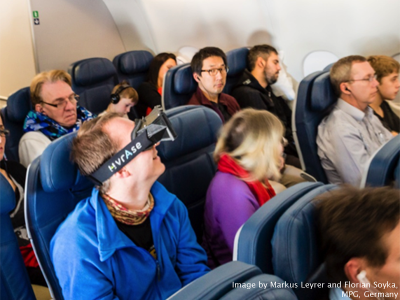Are we virtually there yet? Bringing back the luxury of air travel.
Posted on 21 May 2014
Are we virtually there yet? Bringing back the luxury of air travel.
 By Mirabelle D'Cruz, HFRG Director of European Research, Faculty of Engineering at the University of Nottingham.
By Mirabelle D'Cruz, HFRG Director of European Research, Faculty of Engineering at the University of Nottingham.
This article is part of our series: a day in the software life, in which we ask researchers from all disciplines to discuss the tools that make their research possible.
Aircraft industries are exploring many ways to increase efficiency and capacity of future planes, by adding more seats, having fewer windows and even by providing areas for standing room only. How do these ideas affect us as passengers?
VR-HYPERSPACE has been exploring the use of virtual reality for enhancing passenger comfort by changing how we perceive ourselves and the space around us. Virtual reality (VR) enables us to create and interact with virtual environments (VEs), which can represent real, imaginary or abstract worlds and can be viewed in 2D or 3D on a monitor, projected display or using head-mounted-displays. Other senses - like sound, touch and even smell and taste - can also be engaged though VR interfaces.
The project is led by the University of Nottingham in collaboration with eight other organisations around Europe that brings together leading VR scientists and industries. It is funded by the European Aeronautics and Air Transport work programme.
Based on research into virtual embodiment (using VR to make yourself appear somewhere else) at the University of Barcelona, and space perception research at the Max Planck Institute for Biological Cybernetics, the aim of the VR-HYPERSPACE concepts is to convince users that they feel relaxed, are in a larger space, and are able to carry out activities with other people in a much better way. We have been testing these positive illusions of self and space in a number of experiments and assessing their impact on passenger experience and comfort.
Our Aviation Advisory Board (chaired by industrial partners Airbus Innovations and Thales Alenia Space Italia), suggested that we bring back the excitement of flying, like in the 1940’s when flying was seen as a once-in-a-lifetime event and planes were like luxury hotels.
Using 3D immersive projected displays, headsets and sound, the project has developed concepts to enhance the cabin environment and social interactions. The enhanced cabin concept by Fraunhofer IAO is a mock-up of an aircraft cabin with seats in a row, and 3D displays on the cabin walls, seats in front and even on the floor. VEs can be projected on the displays giving the illusion of an invisible plane. Our super-here scenario enhances features of the plane journey so that the passenger can also just enjoy the experience of flying or be taken out of the plane to another more relaxing environment. Experiments are currently taking place to see the impact on passenger comfort of these scenarios when faced with a very restricted space or the sound of a crying baby.
We also use enhanced social interaction, developed at the Bauhaus-Universität Weimar, which uses the only multi-viewer, multi-user, telepresence VR system in the world. 3D images of people in remote locations can be beamed into your space and you can communicate with them as if they were next to you. So you could be on the plane and a close friend in another country could sit next to you while you watch and discuss a movie together, or you could be beamed into your child’s bedroom to read a story before bedtime so that you are connected to the people you want to be with at all times.
Currently headsets and projected displays have been used to transport passengers into a virtual world. The team has already tested some these concepts on a recent flight from Germany to the US on their way to present the project at the International conference IEEEVR2014, Minneapolis, with headsets used on smart phones. Early results show it really can help time to pass more quickly.
VR-HYPERSPACE also has far-reaching applications in other forms of transport and in healthcare and education. For example, it can transform the lives of hospital patients in confinement and isolation for long periods of time, enabling them to change their environment to a more comfortable space while interacting with their friends and family without risks of infection or the need for constant travel.
As the research project moves into its final stages in the next six months we will be finding out if these ideas could really work, turning virtual reality into reality. To join us on our journey, visit our website.
